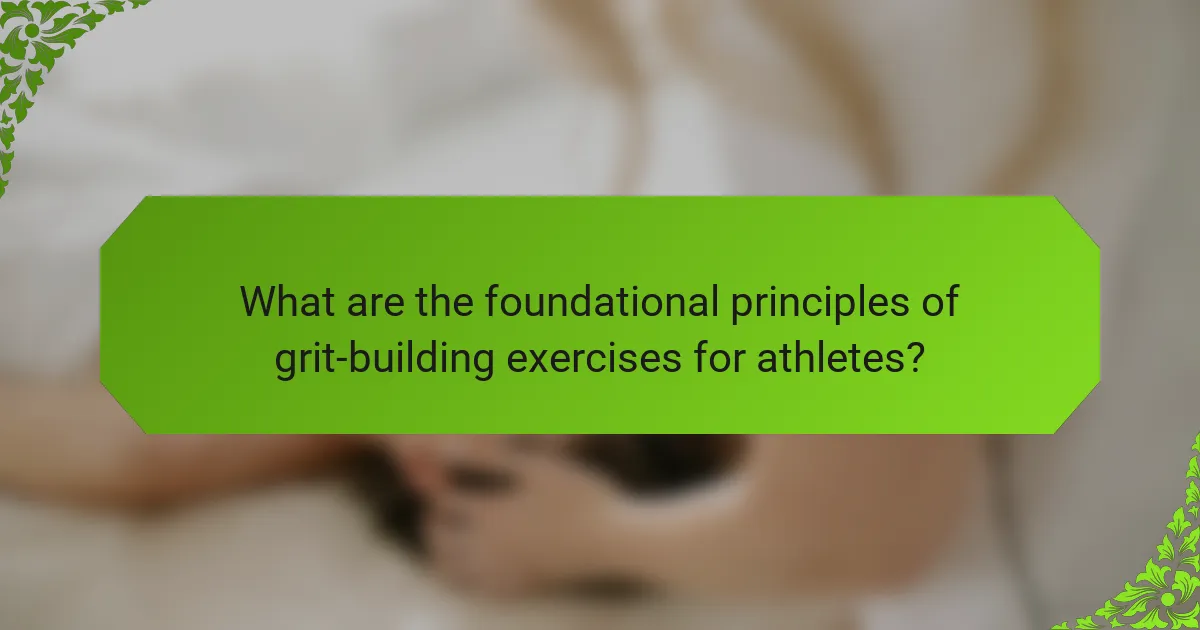Building grit is essential for athletes seeking to enhance performance and overcome challenges. This article explores mental resilience training, goal-setting practices, visualization techniques, and the importance of reflection. It also discusses physical challenges and teamwork as key components in developing a strong mindset. Finally, we will examine how to measure progress and implement these exercises effectively.

What are the foundational principles of grit-building exercises for athletes?
Grit-building exercises for athletes focus on resilience and perseverance. Key principles include goal setting, mental toughness training, and consistent practice. These strategies enhance performance by fostering a strong mindset. Outcomes often include improved focus, increased motivation, and the ability to overcome challenges. Engaging in these practices regularly solidifies grit as a foundational attribute in athletic success.
How does grit impact athletic performance?
Grit significantly enhances athletic performance by fostering resilience and perseverance. Grit-building exercises, such as goal-setting and mental visualization, help athletes cultivate a strong mindset. Research shows that athletes with higher grit levels tend to achieve better outcomes, including improved performance metrics. For example, a study by Duckworth et al. indicates that grit correlates with success in competitive sports. Regular practice of grit-enhancing techniques can lead to sustained motivation and a greater ability to overcome challenges in training and competition.
What psychological theories support grit development?
Psychological theories supporting grit development include Carol Dweck’s growth mindset, Angela Duckworth’s grit theory, and Albert Bandura’s self-efficacy theory. These theories emphasize resilience, perseverance, and the belief in one’s abilities as key components for building grit in athletes. Grit-building exercises, such as goal-setting and reflective practices, can enhance these psychological attributes, leading to improved athletic performance and personal growth.

What are the universal types of grit-building exercises?
Grit-building exercises for athletes include mental resilience training, goal-setting practices, and visualization techniques. These strategies enhance perseverance, focus, and determination.
1. Mental Resilience Training | Develops coping strategies for setbacks and stress.
2. Goal-Setting Practices | Encourages setting specific, measurable, achievable, relevant, and time-bound goals.
3. Visualization Techniques | Involves imagining successful performance to boost confidence and reduce anxiety.
4. Reflection and Journaling | Fosters self-awareness and tracks progress over time.
5. Physical Challenges | Engages in demanding workouts to build mental toughness.
6. Teamwork and Collaboration | Promotes a supportive environment that reinforces collective grit.
What role does physical training play in building grit?
Physical training significantly enhances grit by fostering resilience and perseverance in athletes. Engaging in challenging workouts builds mental toughness, helping athletes push through discomfort and setbacks. Consistent training develops discipline, reinforcing the habit of striving for long-term goals despite obstacles. Furthermore, physical challenges stimulate a growth mindset, encouraging athletes to view failures as opportunities for improvement. This combination of resilience, discipline, and a positive outlook cultivates a strong sense of grit essential for athletic success.
How can goal-setting enhance grit in athletes?
Goal-setting enhances grit in athletes by providing clear objectives that foster perseverance. When athletes set specific, measurable goals, they develop a focused mindset that encourages resilience. This process creates a framework for tracking progress, which reinforces motivation and commitment. Research indicates that athletes who engage in goal-setting report higher levels of determination and sustained effort, contributing to improved performance and personal growth. By regularly revisiting and adjusting their goals, athletes cultivate a growth mindset that strengthens their ability to overcome challenges.
What are the benefits of resilience training?
Resilience training enhances mental toughness, enabling athletes to overcome challenges. Key benefits include improved focus, better stress management, and enhanced motivation. Grit-building exercises foster persistence, which is crucial for long-term success in sports. Additionally, athletes develop a growth mindset, allowing them to view setbacks as opportunities for growth.

What unique strategies can be employed to cultivate grit?
To cultivate grit, athletes can employ strategies such as setting challenging goals, developing a growth mindset, and practicing resilience through adversity. These approaches enhance perseverance and determination.
Setting specific, measurable goals encourages athletes to push their limits. Developing a growth mindset fosters a belief in improvement through effort. Practicing resilience involves facing setbacks and learning from failures, ultimately strengthening mental toughness.
Incorporating these strategies consistently leads to improved performance and greater success in athletic pursuits.
How can visualization techniques foster grit in athletes?
Visualization techniques can significantly enhance grit in athletes by improving focus and resilience. These methods help athletes mentally rehearse their performance, fostering a strong sense of determination and perseverance.
Visualization exercises, such as mental imagery and guided visualization, enable athletes to envision success and overcome obstacles. Research shows that consistent practice of these techniques can lead to improved performance outcomes and increased mental toughness.
By regularly engaging in visualization, athletes can build a positive mindset, which is a unique attribute that contributes to their overall grit. As a result, they develop the ability to push through challenges and maintain motivation during difficult training or competition scenarios.
What is the impact of mentorship on grit development?
Mentorship significantly enhances grit development in athletes by providing guidance, support, and accountability. Mentors help athletes set challenging goals and develop resilience through constructive feedback. This relationship fosters a growth mindset, encouraging athletes to persist through setbacks. Studies indicate that athletes with mentors demonstrate higher levels of perseverance and commitment to their training. Additionally, mentorship can lead to improved mental toughness, a unique attribute that distinguishes successful athletes.

What rare attributes can influence grit-building effectiveness?
Rare attributes that can influence grit-building effectiveness include individual resilience, adaptive learning styles, and intrinsic motivation. These factors enhance an athlete’s ability to persevere through challenges and foster a growth mindset. For instance, athletes with high intrinsic motivation often show greater commitment to long-term training regimens, significantly impacting their grit development. Additionally, unique personal experiences can shape how athletes respond to adversity, further influencing their grit-building journey.
How do cultural factors shape grit in athletes?
Cultural factors significantly influence grit in athletes by shaping their values, beliefs, and responses to challenges. These factors include societal expectations, family support, and community norms. For instance, cultures that emphasize perseverance and resilience often cultivate higher levels of grit among athletes. Additionally, cultural narratives surrounding success and failure can impact an athlete’s mindset, motivating them to adopt grit-building exercises. These exercises may include goal-setting, visualization, and stress management techniques, leading to improved performance and mental toughness. As a result, understanding cultural influences is essential for developing effective grit strategies tailored to individual athletes.
What are the effects of competitive environments on grit?
Competitive environments enhance grit by fostering resilience and determination in athletes. These settings challenge individuals to push their limits and overcome obstacles. As a result, athletes develop mental toughness, which is crucial for long-term success. Research shows that exposure to high-pressure situations can lead to improved performance and persistence in training. Grit-building exercises such as goal setting, visualization, and self-reflection are effective strategies that athletes can adopt to thrive in competitive contexts. These practices not only enhance grit but also contribute to overall athletic development and achievement.

How can athletes measure their grit progress?
Athletes can measure their grit progress through self-assessment tools, performance metrics, and reflection practices. Utilizing standardized grit scales, such as the Grit Scale by Angela Duckworth, helps quantify resilience and perseverance. Tracking performance improvements in training and competitions also offers tangible evidence of grit development. Regularly reflecting on challenges faced and personal growth fosters deeper insights into grit progress.
What tools are available for assessing grit levels?
Various tools assess grit levels in athletes, including questionnaires, performance metrics, and psychological assessments. The Grit Scale, developed by Angela Duckworth, is a widely used questionnaire that quantifies grit through self-reported items. Performance metrics can include endurance tests and competition outcomes, reflecting perseverance and passion over time. Psychological assessments, such as interviews or observational studies, provide deeper insights into an athlete’s mindset and resilience. These tools help coaches tailor grit-building exercises effectively.
How can feedback loops enhance grit training?
Feedback loops significantly enhance grit training by providing athletes with continuous insights into their performance and progress. These loops foster self-reflection, allowing athletes to identify strengths and weaknesses. Regular feedback encourages perseverance through challenges, reinforcing the development of resilience. Moreover, tailored feedback can motivate athletes to set and achieve specific goals, further cultivating their grit. This iterative process ultimately leads to improved outcomes and sustained commitment to training.

What are the best practices for implementing grit-building exercises?
To implement grit-building exercises effectively, focus on consistency, challenge, and reflection. Athletes should engage in progressively difficult tasks that push their limits. Incorporate regular feedback sessions to assess progress and adjust strategies. Utilize visualization techniques to enhance mental resilience. Encourage a growth mindset by celebrating effort over outcome.
What common mistakes should athletes avoid when developing grit?
Athletes should avoid common mistakes that hinder grit development. These include setting unrealistic goals, neglecting mental recovery, and failing to embrace discomfort.
Setting achievable goals fosters motivation and builds resilience. Neglecting mental recovery can lead to burnout, undermining grit. Embracing discomfort is essential; athletes must push through challenges to strengthen their mental toughness.
How can athletes optimize their grit-building routines?
Athletes can optimize their grit-building routines by incorporating specific strategies that enhance resilience and perseverance. Key practices include setting challenging yet achievable goals, engaging in deliberate practice, and maintaining a growth mindset.
Additionally, athletes should focus on consistent self-reflection to identify strengths and areas for improvement. Techniques such as visualization and positive self-talk can further reinforce determination. As a result, these strategies lead to improved performance and mental toughness, essential attributes for success in competitive sports.
What expert insights can guide grit development in sports?
Grit development in sports can be guided by targeted exercises that enhance resilience and perseverance. Strategies like goal-setting, visualization, and reflective journaling effectively cultivate grit. Research indicates that athletes who engage in these practices show improved performance and mental toughness. For example, a study found that athletes who set specific, challenging goals were 20% more likely to achieve them.


